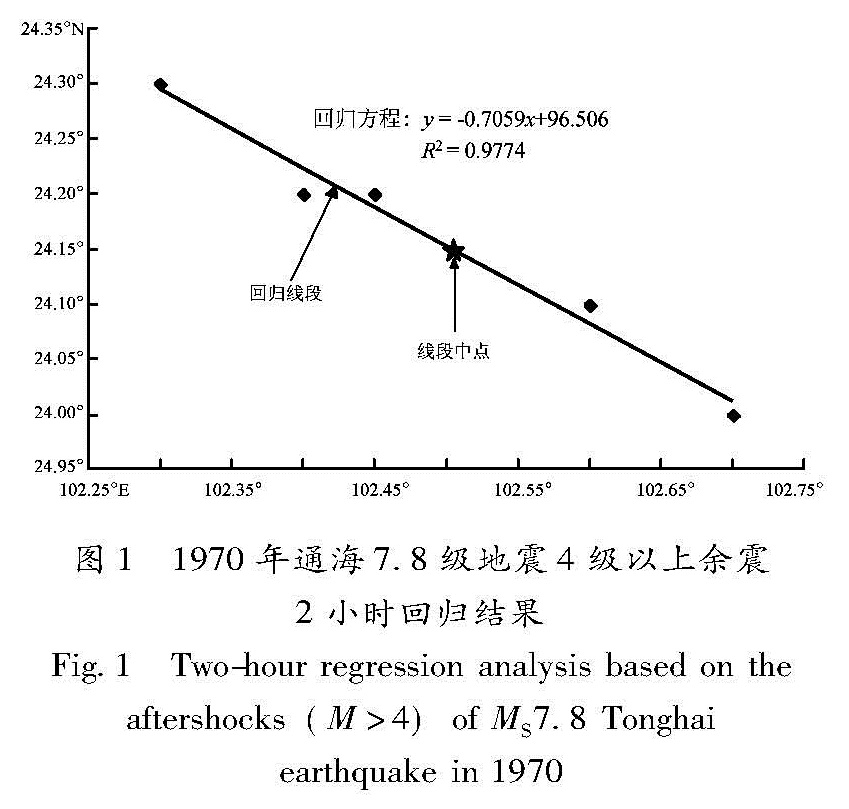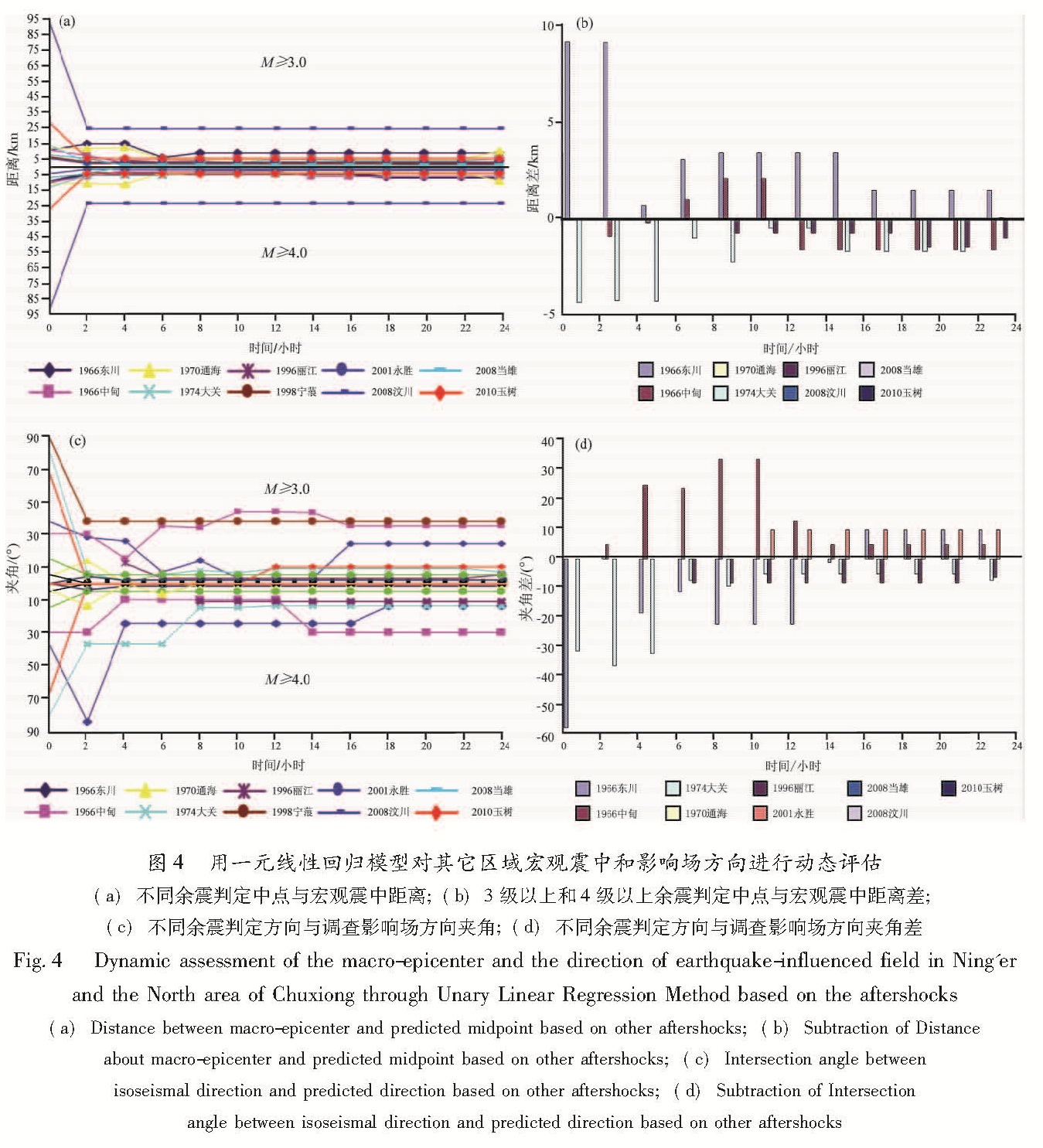基金项目:地震应急青年课题(ECA-EDEM-201013)行业专项:西南地震应急对策新模式与关键技术研究(201108013)国家科技支撑计划:中国西部高原地区强震山体滑坡次生地质灾害及灾害链风险评估模型研究(2008BAK50B03-04-01)联合资助.
(1.云南省地震局,云南 昆明 650224; 2.昆明市西山区防震减灾局,云南 昆明 650118)
(1. Earthquake Administration of Yunnan Province,Kunming 650224,Yunnan,China)(2. Earthquake Administration of Xishan District,Kunming City,Kunming 650118,Yunnan,China)
aftershocks; macro-epicenter; Isoseisma direction; simple linear regression
备注
基金项目:地震应急青年课题(ECA-EDEM-201013)行业专项:西南地震应急对策新模式与关键技术研究(201108013)国家科技支撑计划:中国西部高原地区强震山体滑坡次生地质灾害及灾害链风险评估模型研究(2008BAK50B03-04-01)联合资助.
选取了1966年以来云南地区22个MS≥6.0震例的地震影响场和余震序列,对两者的关联度进行空间统计分析。将余震分级后按2小时递增进行时段划分,然后用一元线性回归方法对各组余震数据进行线性模型回归。采用自变量极值法控制回归直线的范围,将得到的回归线段中点判定为宏观震中,线段方向判定为影响场方向。结果 表明:此方法判定的结果总体上比较接近各震例的宏观震中和影响场方向。
Collecting the isoseismal map and aftershocks of 22 earthquake events(M≥6.0)occurred in Yunnan since 1966,we studied a method for the rapid assessment of the macro-epicenter and earthquake-effected field. Firstly,we classified the aftershocks by magnitude and time into different groups,then we calculated the data of every group by simple linear regression. Controlling the length of regressive line through Variable Extreme Value method,we regarded the middle point of the regressive line as the macro-epicenter,and the line's direction as the isoseisma's direction. The results are generally in line with the data got by the field survey.
引言
在开展地震现场调查之前,迅速对地震造成的损失进行评估,对地震应急救援决策非常重要(王晓青等,2009)。通常根据本地区的地震衰减关系确定地震影响场,然后根据已有的易损性分析结果估计破坏状态(成小平,1998)。随着信息技术迅猛发展和广泛应用,等震线模型的研究与空间信息技术应用结合越来越紧密,最具代表的是我国“十五”期间建设和投入使用的“区域地震应急指挥技术系统”(以下简称系统),该系统在我国的地震应急工作中发挥了重要的作用。系统中地震影响场衰减关系模型包括圆模型、椭圆模型、东部椭圆模型、西部椭圆模型、东部圆模型、西部圆模型等,默认的椭圆模型长轴方向与距离震中最近断层的首尾连线的方向平行,仪器震中默认为评估的宏观震中,其评估结果与实际有差别。汶川MS8.0大地震发生后,现有的评估系统计算结果几乎都与实际有较大的差距,影响了救灾效果(李志强等,2008),评估结果的最大不确定来自于对地震影响场的估计(王晓青等,2009)和大震造成的通信瘫痪。
对余震时空分布的规律研究(谷继成等,1982; 王碧泉,王春珍,1983; 周仕勇,许忠淮,1999; 游凤林等,2001; 蒋海昆等,2007)表明,余震在时间和空间分布上有自身的衰减关系,大地震后几个小时内余震的分布范围大体上和主破裂长度相当(吕培苓,1983)。汶川地震余震震中沿东北—南西方向展布(黄媛等,2008; 高孟谭等,2008),其分布方向与实际等震线的方向一致,1970年通海地震等震线方向和余震分布的方向也一致(张淑蓉,1980)。这表明我们可以通过余震信息来判定宏观震中和影响场方向。
云南省是一个多震地区,有丰富的历史地震资料,能提供有价值的参数(秦嘉政,1992)。同时云南还是中国震亡人员多的地区之一(李永强等,2007)。未来一段时间内,云南仍然面临着严峻的强震形势。根据20世纪云南MS6.7以上强震呈现有序的时空迁移轮回规律(皇甫岗等,2000; 刘祖荫等,2002)外推,下一强震活动主体活动地区在云南东部。根据20世纪云南4个地震活动期的人员伤亡数据(李永强,2009)统计,东部强震活动期的人员震亡在万人以上。因此在云南地区开展基于余震信息的地震影响场判定方法具有充分的基础资料和迫切的现实需求。
1 云南地区震例数据〖*3〗
1.1 数据收集和预处理笔者共收集云南地区1966年以来有余震记录的MS6.0以上震例的数据,外加3个近年来发生在我国西部地区的震例作为研究资料,这3外加个震例作为研究云南地区的一个参考(表1)。
地震影响场数据主要来自云南省地震应急基础数据库,为Shape格式,玉树地震、当雄地震、姚安地震三个震例影响场数据来源于灾评报告,为JPG格式。余震序列由云南省地震局预报中心和监测中心共同提供,为EQT格式。
收集的数据类型包括Shape格式的空间数据、JPG格式扫描数据、EQT格式余震序列数据3种不同类型的数据,各类数据分别处理如下:
Shape数据:在ARCGIS下将所有Shape格式数据定义为相同的投影和坐标系统。
JPG数据:在ARCGIS平台上定义为与Shape格式数据相同的投影和坐标系统后进行影响场矢量化。
EQT数据:将EQT数据转换为ARCGIS支持的EXCEL数据,然后生成与基础数据库中影响场数据具有相同投影和坐标系统的Shape格式数据。
1.2 数据分析数据分析和处理是快速判定云南地区MS≥6.0地震不同震级影响场的基础,本研究的目标是解决在现场灾情信息空缺时,短时间内对地震影响场信息的快速评估,即应急目标下的地震影响场信息判定。故在分析时只选取了地震后24小时内的余震信息。将各震例的余震先按照3级及以上、4级及以上、5级及以上进行分级,再按照2小时递增进行时间分段。然后将地震影响场与各组余震空间分布进行图层叠加,宏观判定地震影响场与余震时、空、强之间的关系。地震影响场与各组余震空间分布图层叠加图共215幅,从结果看,大多数地震余震的空间分布与等震线的长轴方向总体一致、余震分布的几何中心与等震线的中心也较为接近。
笔者着重研究主震余震型地震事件,1976年5月29日龙陵MS7.4地震(双震)的影响场最为复杂(李永强等,2007),1988年澜沧—耿马地震属于双震型地震,这两个震例被排除在外。本研究中没有考虑3级以下余震的原因为:(1)大多震例3级以下余震为单台测定结果,没有标定发震位置;(2)MS≥7.0地震在24小时内几乎没有3级以下的余震记录。从数据处理结果看,除了1971年宁洱MS6.7地震和2000年姚安MS6.5地震外,其余震例的影响场与余震时间、空间、强度有明显的一致性,且这种一致性不因余震震级的增加和时间的变化而变化(汶川MS8.0地震除外),这种普遍性表现为3级及以上余震2小时的空间分布与相应地震事件高烈度区范围基本一致; 但这种规律却有明显的地域特征,基本上宁洱地区、楚雄北部(大姚、姚安、武定一带)3级及以上余震2小时的空间分布与相应地震事件高烈度区范围比较一致,其他地区4级及以上余震4~8小时的余震分布范围与相应地震事件高烈度区范围更趋一致。
2 宏观震中和影响场方向判定
从上述研究可以得知,余震的时间、空间、强度在很大程度上反映了地震影响场信息,因此,可以通过余震信息反演宏观震中和影响场方向。笔者定义影响场方向为影响场的长轴方向。
2.1 宏观震中和影响场方向判定方法经反复试验,最后采用一元线性回归模型建立宏观震中和影响场方向与余震时间、空间、强度关系的统计模型。一元线性回归分析是根据统计资料,寻求一个变量对另一个变量的恰当数学表达式来近似地表示变量间的平均变化关系的一种统计分析方法。它是描述两个变量之间相关关系的最简单的回归模型(徐建华,2002)。一元线性回归模型为
Y=β0+β1X+υ.(1)
其中,Y为被解释变量(因变量); X为解释变量(自变量); β0和β1是未知参数,称为回归系数; υ是不可观测的随机变量,表示 X和 Y关系中的不确定因素的影响。
Fig. 1 Two-hour regression analysis based on the aftershocks(M>4)of MS7.8 Tonghai earthquake in 1970将各震例分组后的余震坐标分别作为变量和自变量,用上述方法建模,即得到各组数据的回归方程:Y=β0+β1X+υ,通过回归方程得到相应的直线,直线的方向即可判定为影响场的方向。得到回归方程后,只是得到了影响场的方向,经反复研究和比较,采用样本数据中自变量的极大值和极小值来控制样本尺度,回归结果则为一条线段,将线段的中点判定为震例的宏观震中。以通海地震4级及以上余震2小时的回归结果为例,线段方向判定为影响场方向,线段中点判定为宏观震中(图1)。
2.2 宏观震中和影响场方向判定结果对判定结果的分析主要是评价判定的震中与宏观震中、回归线段方向与影响场方向的接近程度,即量算判定结果的精度。用宏观震中与判定震中的距离和影响场方向与判定方向角度的绝对差来描述分析结果,同时也将系统评估结果(以下简称系统评估)与调查影响场方向和宏观震中偏差做比较(图2)。
从图2和图3可以看出,除1970年宁洱地震外,基于余震信息用一元线性回归法判定的宏观震中和影响场方向总体上比系统评估更符合云南地区实际情况。而且2小时的判定结果与2小时以后的判定结果没有本质差别,即2小时后的判定中点与宏观震中距离以及判定方向与影响场方向夹角不因时间的延续发生规律的变化,反而个别事件的判定精度因时间延续在一些时段降低。换言之,判定精度与时间的延续没有规律性的关联,总体上2小时判定结果更适合用于影响场评估。
虽然基于余震信息用一元线性回归法判定的宏观震中和影响场方向精度没有明显的时间性,但却表现出明显的区域性。数据分析表明,宁洱地区、楚雄北部(大姚、姚安、武定一带)与其他区域有明显的区域差异。为了分析本判定方法区域性的适用状况,将宁洱地区、楚雄北部(大姚、姚安、武定一带)与其他区域分开比较,同时为了比较3级及以上余震和4级及以上余震在不同区域不同时段的判定精度,采用3级及以上余震判定结果(距离和夹角)减去4级及以上余震判定结果,如果结果为负,说明3级及以上余震判定的结果更精确,反之则说明4级及以上余震判定结果更精确。
从图3a可以看出,宁洱和楚雄北部3级及以上余震2小时判定的震中精度最理想,除2000年的姚安地震外,3级及以上余震2小时判定的震中均比评估系统计算的中点更接近宏观震中; 从图3b可以看出,3级及以上余震判定的震中距离减去4级及以上余震判定的震中距离所得结果(除1970年宁洱地震外)均为负值,表明这些地区3级及以上余震判定的宏观震中精度远比4级及以上余震判定的宏观震中精度高,即基于2小时3级及以上余震信息采用一元线性回归方法判定宁洱、楚雄北部(大姚、姚安、武定一带)宏观震中精度更高。
从图3c可以看出,宁洱和楚雄北部3级及以
上余震2小时内判定的影响场方向精度最理想,3级及以上余震2小时判定的方向与影响场夹角最小,也远比系统评估方向与影响场方向的夹角小,相反4级及以上余震判定的方向比系统评估的偏差大; 从图3d可以看出,3级及以上余震判定的方向与影响场夹角减去4级及以上余震判定的方向与影响场夹角,除1970年宁洱地震和1973年宁洱地震6小时以后的结果外,均为负值,表明这些地区3级及以上余震判定的影响场方向精度远比4级及以上余震判定的影响场方向精度高。从这些统计结果以及统计数据表现出来的特征说明,基于2小时3级及以上余震信息采用一元线性回归方法判定
图2 用一元线性回归法基于余震信息判定的宏观震中和影响场方向(a)3级以上余震判定中点与宏观震中距离;(b)4级以上余震判定中点与宏观震中距离;(c)3级以上余震判定方向与调查影响场方向夹角;(d)4级以上余震判定方向与调查影响场方向夹角
Fig.2 Predicted macro-epicenter and the direction of earthquake-influenced field through Unary Linear Regression Method based on the aftershocks (a)Distance between macro-epicenter and predicted midpoint based on the M>3 aftershocks;(b)Distance between macro-epicenter and predication midpoint based on the M>4 aftershocks;(c)Intersection angle between isoseismal direction and predicted direction based on the M>3 aftershocks;(d)Intersection angle between isoseismal direction and predicted direction based on the M>4 aftershocks宁洱、楚雄北部(大姚、姚安、武定一带)的宏观震中和影响场方向精度更高。
从图4a得知,总体上云南其它区域2小时3级及以上余震判定的中点与宏观震中的距离比4级及以上余震判定的中点与宏观震中的距离小,即2小时,3级及以上余震判定的宏观震中精度更高,但2小时以后,特别是达到8小时的时候,总体上4级
及以上余震判定的中点与宏观震中的距离最小,且比3级以上余震判定的中点与宏观震中的距离还小。根据3级及以上余震判定结果减去4级及以上余震判定结果看(图4b),总体也是前6个小时负值优势度明显,8小时后正值的优势度变得明显。
从图4c可知,对影响场方向的判定存在与对宏观震中判定类似的现象。2小时内,总体上3级
图3 用一元线性回归法判定宁洱和楚雄北部的宏观震中和影响场方向
(a)不同余震判定中点与宏观震中距离;(b)3级以上和4级以上余震判定中点
与宏观震中距离差;(c)不同余震判定方向与调查影响场方向夹角;
(d)不同余震判定方向与调查影响场方向夹角差
Fig.3 Predicted macro-epicenter and the direction of earthquake-influenced field in Ning'er and the North area of Chuxiong through Unary Linear Regression Method based on the aftershocks(a)Distance between macro-epicenter and predication midpoint based on the aftershocks in Ning'er and the North area of Chuxiong; (b)Subtraction of distance about macro-epicenter and predication midpoint based on the aftershocks in Ning'er and the North area of Chuxiong;(c)Intersection angle between isoseismal direction and predication direction based on the aftershocks in Ning'er and the North area of Chuxiong;(d)Subtraction of intersection angle between isoseismal direction and predicted direction based on the aftershocks in Ning'er and the North area of Chuxiong及以上余震判定的方向与调查影响场方向夹角比4级及以上余震判定的方向与调查影响场方向夹角小,精度更高,但2小时以后,特别是达到8小时的时候,总体上4级及以上余震判定的方向与调查影响场方向夹角最小,且比3级及以上余震判定的方向与调查影响场方向夹角还小。根据3级及以上余震判定结果减去4级及以上余震判定结果看(图4d),总体上也是前6个小时负值优势度明显,8小时后正值的优势度变得明显。从这些统计结果以及统计数据表现出来的特征说明,云南省其它
地区在地震发生后2个小时内,适合基于3级及以上余震信息采用一元线性回归模型判定宏观震中和影响场的方向,地震后8小时4级及以上余震适合采用一元线性回归模型对宏观震中和影响场方向进行动态评估。
3 结论与讨论
在云南地区,笔者对MS6.0以上震例的余震进行分级分时处理后,用一元线性回归方法来反
图4 用一元线性回归模型对其它区域宏观震中和影响场方向进行动态评估
(a)不同余震判定中点与宏观震中距离;(b)3级以上和4级以上余震判定中点与宏观震中距离差;
(c)不同余震判定方向与调查影响场方向夹角;(d)不同余震判定方向与调查影响场方向夹角差
Fig.4 Dynamic assessment of the macro-epicenter and the direction of earthquake-influenced field in Ning'er and the North area of Chuxiong through Unary Linear Regression Method based on the aftershocks (a)Distance between macro-epicenter and predicted midpoint based on other aftershocks;(b)Subtraction of Distance about macro-epicenter and predicted midpoint based on other aftershocks;(c)Intersection angle between isoseismal direction and predicted direction based on other aftershocks;(d)Subtraction of Intersection angle between isoseismal direction and predicted direction based on other aftershocks演宏观震中和影响场方向能取得较为理想的效果。总体上,用2小时3级及以上余震的信息判定的宏观震中和影响场方向结果具有普遍的实用性。
(1)区域性。在云南地区,基于余震信息用一元线性回归法判定的宏观震中和影响场方向精度具有区域性,从总体情况看,宁洱地区和楚雄北部(大姚、姚安、武定一带)3级及以上余震2小时判定的结果精度较高,适合判定宏观震中和影响场方向; 其它地区2小时3级及以上余震信息适合用来初判定宏观震中和影响场方向,达到8小时的时候4级及以上余震信息适合动态评估宏观震中和影响场方向。
(2)等级性。从基于余震信息的宏观震中和影响场方向判定结果来看,2小时3级及以上的余震判定精度更高,无论是3级及以上余震还是4级及以上余震,其判定结果不存在随着时间的延长而出现判定精度的规律性变化。但是针对不同区域,不同震级的余震在特定时段内有其特定的适用性,具体而言,3级及以上余震2小时的判定结果适合整个云南地区,4级及以上余震8小时的判定结果适合对宁洱地区、楚雄北部以外区域进行动态修正评估。
(3)实用性。基于余震信息的宏观震中和地震影响场方向判定方法研究的样本主要是基于云南地区外加3个西部地区近年来发生的6.6级以上地震震例,因此目前其实用性只能暂定为云南地区,对其他地区的适用情况有待进一步研究。
- 成小平.1998.地震影响场动态评估的神经网络模型[C].//中国地震学会第七次学术大会论文摘要集.北京:地震出版社:160-160.
- 高孟潭,周本刚,潘华.2008.“5·12”汶川特大地震灾害特点及其防灾启示[J].震灾防御技术,3(3):209-215.
- 谷继成,谢小碧,赵莉.1982.强余震的空间分布特征及其理论解释[J].地震学报,4(4):380-388.
- 黄媛,吴建平,张天中,等.2008.汶川8.0 级大地震及其余震序列重定位研究[J].中国科学D辑:地球科学,38(10):1242-1249.
- 皇甫岗,石绍先,苏有锦.2000.20世纪云南地震活动研究[J].地震研究,23(1):1-9.
- 蒋海昆,郑建常,吴琼,等.2007.中国大陆中强以上地震余震分布尺度的统计特征[J].地震学报,29(2):151-164.
- 李志强,袁一凡,李晓丽,等.2008.对汶川地震宏观震中和极震区的认识[J].地震地质,30(3):768-777.
- 李永强.2009.云南人员震亡研究[D].安徽:中国科学技术大学.
- 李永强,王景来,曹刻,等.2007.云南地震灾害与地震应急[M].北京:地震出版社:23-38.
- 吕培苓.1983.大地震后短时间内余震活动时空分布的某些研究[J].地震学报,5(1):39-46.
- 刘祖荫,苏有锦,秦嘉政,等.2002.二十世纪云南地震活动[M].北京:地震出版社.
- 秦嘉政.1992.云南地震烈度与震级的统计分析[J].地震研究,15(1):37-45.
- 王碧泉,王春珍.1983.余震序列的时空特征[J].地震学报,5(4):383-396.
- 王晓青,丁香,王龙,等.2009.四川汶川8 级大地震灾害损失快速评估研究[J].地震学报,31(2):205-211.
- 徐建华.2002.现代地理学中的数学方法[M].北京:高等教育出版社.
- 游凤林,苏金蓉,蔡一川.2001.雅江地震序列时空分布特征[J].四川地震,(4):21-26.
- 张淑蓉.1980.1970年1月5日通海地震序列特征[J].地震研究,3(2):11-18.
- 周仕勇,许忠淮.1999.地震序列研究综述[J].中国地震,15(3):268-277.





